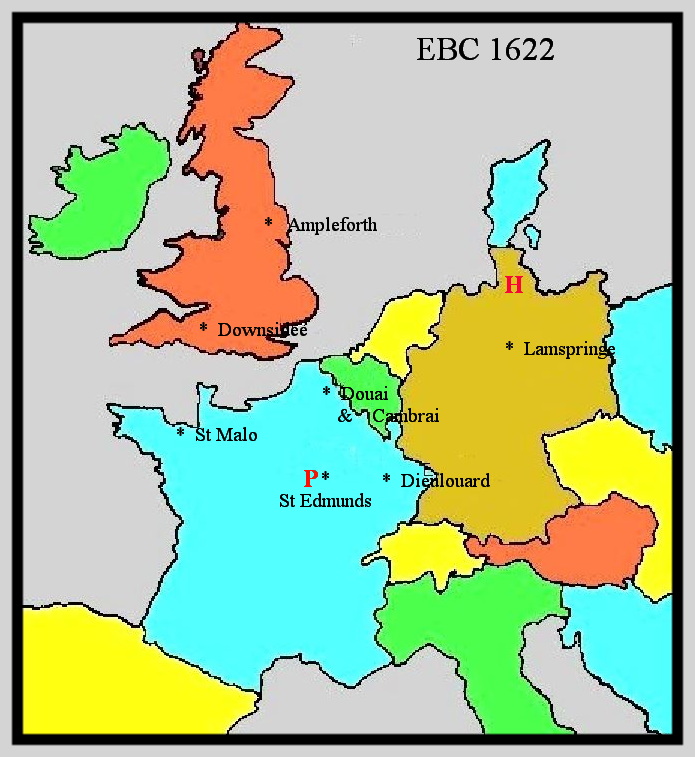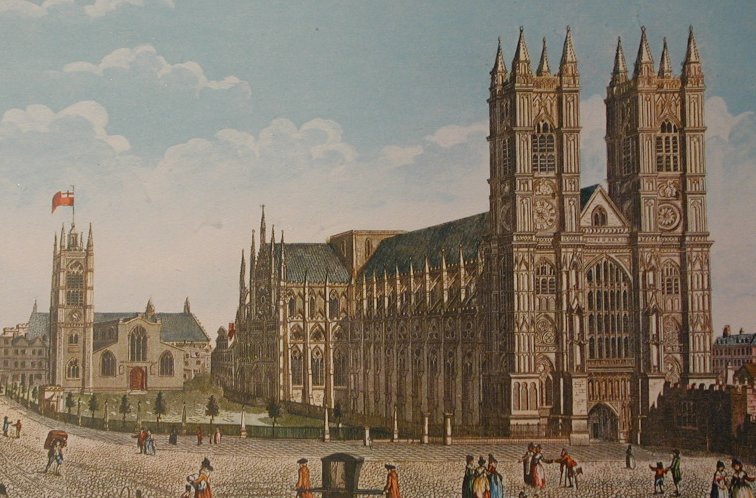THIRTEEEN ABBEYS
Downside
Ampleforth
Douai
Stanbrook
Belmont
Curzon Park
Colwich *
Ealing
Buckfast
Washington
Worth
Portsmouth
St Louis
Of these, Stanbrook, Curzon Park and Colwich are of nuns.
Washington, Portsmouth & St Louis are in the USA.
* In May 2020 Colwich was affiliated with Stanbrook, due to reduced numbers.
PAST MONASTERIES
St Malo 1611-69
Rinteln 1628-31
Lamspringe 1643-1803
Broadway 1830-41
Fort Augustus 1878-1998
Holme Eden 1892-1983
There were also the former sites in exile of the older houses, Douai, Dieulouard, Paris & Cambrai
THE CONGREGATION
The EBC has its own site: this one is maintained by St Laurence's, and is concerned only with the history of the EBC, its houses and its deceased members.

About this Site www.plantata.org.uk *

The English Benedictine Congregation (EBC) was first formed in 1216, but lapsed (or just faded away) at the Dissolution of the monasteries in 1535-40. It was revived and restored by Rome (1607-33) when numbers of Englishmen had become monks in Italian or Spanish monasteries and were coming to England as Missioners. It has been active ever since, and its General Chapter has met every four years (almost exactly so) up to the present.
* Plantata is the first word, and so the name, of the Roman document (1633) which finally confirmed the renewal of the English Benedictines.Parts of the Site
- Dieulouard: after 400 Years (1608-2008)
- Roman and other Documents about the EBC
- Conference Papers from the annual History Symposium 1975 to date: many texts available
- Monks and Nuns: individuals; only those who are dead at present
- Early community sizes: G, L, E, S
- General Chapter List
- Future Symposium meetings Open to anyone interested
- 1793: The Great Return to England
- Contact Editor
Westminster - the link
The first act of the Dies Memorabilis took place on the feast of the Presentation of our Lady, 21 November 1556. On that day Abbot Feckenham with fourteen Benedictine monks took possession of the restored Abbey of St Peter's, Westminster. The second and most important act took place on the feast of the Presentation, 21 November, 1607, when Father Sigebert Buckley, the last surviving monk of Westminster, clothed and professed the two novices, Robert Sadler and Edward Maihew. This ceremony took place (some have said in Westminster Gatehouse) in the presence of Fathers Preston and Beech who witnessed Father Buckley's signature to the legal instrument of affiliation to Westminster Abbey by which Fathers Sadler and Maihew were aggregated, incorporated and made the direct successors of the old English Benedictine Congregation.
Only when the deed was signed did the actors realize that the aggregation had taken place on the same day as the restoration of the Abbey under Queen Mary, and so making for them and for us the Presentation of Our Lady a special anniversary, a Dies Memorabilis. Westminster Abbey was allowed to be restored by an Act of Parliament in 1556. Queen Mary nominated to the Abbacy Doctor John Feckenham, a learned and pious monk of Evesham. He gathered round him fourteen Benedictine monks and entered into possession of his Abbey on 21 November, 1556. This revival of St Peter's lasted only two years and eight months. On 12 July 1559 the monks were driven out, and have not yet returned.
Amongst those professed by Abbot Feckenham was Father Sigebert Buckley, a native of Staffordshire. He refused to take the oath of supremacy, and suffered imprisonment all during Elizabeth's reign. At the accession of James I, he was released from the prison of Framlingham. In the same year 1603 two English monks of the Cassinese congregation, Fathers Preston and Beech, arrived at Yarmouth, and found Father Sigebert in the house of Mr Francis Woodhouse. The 86 year old Confessor of the Faith was willing and anxious to pass on at once the habit and the succession of Westminster.
How to do this legally caused a delay of four years. The difficulty was at last overcome by a young lawyer of Abergavenny who had gone to Italy to fulfil a vow and had returned a Benedictine monk. Br Augustine Baker drew up a legal instrument for the aggregation and succession which satisfied all ecclesiastical law. It is said that it was a secular priest, Arthur Pitts, an exile in Lorraine, who recommended Sadler and Maihew to receive the succession of Westminster. From 1607 until the union in 1619 there were three groups of English monks of St Benedict:
- Those belonging to the Cassinese Congregation beginning 1589
- Those belonging to the Spanish Congregation beginning 1600
- Those belonging to Westminster beginning 1607
It was Prior Maihew's policy that all English Benedictines should have English independence. This policy was accepted and led to the union of 1619. From that time the English Benedictine Congregation was relieved of Cassinese and Spanish jurisdiction.
© 2009 Ampleforth Abbey Trustees